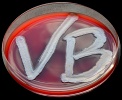| Species/Subspecies: | Rickettsia helvetica | ||||||||
|---|---|---|---|---|---|---|---|---|---|
| Category: | Primarily of interest in human medicin | ||||||||
| Etymology: | Genus name: Named after Howard T. Ricketts, who showed which organism caused Rocky Mountain spotted fever, which resulted in his death Species epithet:from Switzerland. | ||||||||
| Significance: | [Of minor importance] | ||||||||
| Taxonomy: | Class Alphaproteobacteria Order Rickettsiales Family Rickettsiaceae Genus Rickettsia |
||||||||
| Type Strain: | C3 = ATCC VR-1375 | ||||||||
| Macromorphology (smell): | Cannot be cultivated on cell free substrates (for instance agar plates). | ||||||||
| Micromorphology: | Pleomorphic rods (0.3-0.5 x 0.8-2.0 µm). | ||||||||
| Gram +/Gram -: | |||||||||
| Catalase/Oxidase: | |||||||||
| Spec. Char.: | |||||||||
| Special Media: | |||||||||
| Vector: | Tick (Ixodes ricinus). | ||||||||
| Disease: | Tick borne rickettsiosis |
||||||||
| Hosts: | Humans | ||||||||
| Clinical Picture: | |||||||||
| Genome Sequence: |
|
||||||||
| 16S rRNA Seq.: |
| ||||||||
| Taxonomy/phylogeny:
|
About 30 species have been described within the genus Ricketsia. This genus is relatively closely related to other genera within the orderRickettsialas (Anaplasma, Ehrlichia and Neorickettsia). | ||||||||
| Comment: | An evolutionary interesting bacterium, because its ancestors invaded cells and formed the mitochondria by endosymbiosis. | ||||||||
| Updated: | 2023-03-22 |
